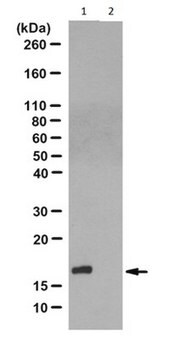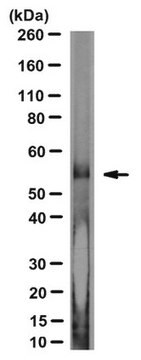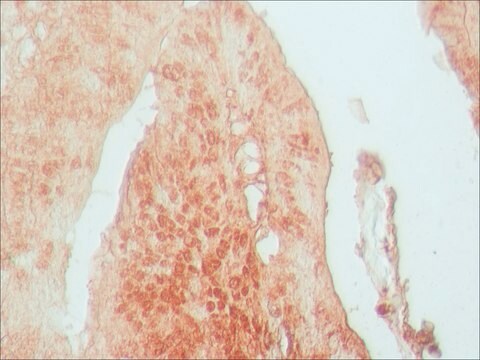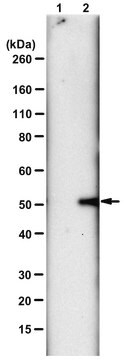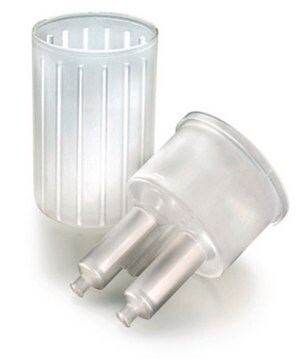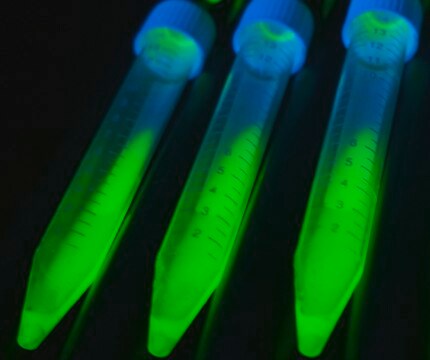ABS1670
Anti-Phosphohistidine (pHis)
from rabbit, purified by affinity chromatography
Synonym(e):
pHis, phosphohistidine
About This Item
Empfohlene Produkte
Biologische Quelle
rabbit
Qualitätsniveau
Antikörperform
affinity isolated antibody
Antikörper-Produkttyp
primary antibodies
Klon
polyclonal
Aufgereinigt durch
affinity chromatography
Speziesreaktivität
all, human, sheep, mouse
Methode(n)
ELISA: suitable
dot blot: suitable
immunoprecipitation (IP): suitable
western blot: suitable
Versandbedingung
ambient
Posttranslationale Modifikation Target
phosphorylation (pHis )
Angaben zum Gen
human ... PHPT1(29085)
Allgemeine Beschreibung
Spezifität
Immunogen
Anwendung
Zelluläre Signaltransduktion
Western Blotting Analysis: A 1:120 dilution from a representative lot detected proteins with histidine phosphorylation in sheep trachea cytosolic extract and human cell lysates, including 16HBE14o-, HEK293T, THP-1, and THP-1-derived macrophages (Courtesy of Bezaleel Mambwe, Richmond Muimo and RFW Jackson, Department of Infection, Immunity and Cardiovascular Disease/ Department of Chemistry, University of Sheffield, UK).
ELISA Analysis: A representative lot detected pHis- and pPza-, but not pTyr-, pSer-, pThr-, conjugated BSA or unconjugated BSA (Lilley, M., et al. (2015). Chem. Commun. (Camb). 51(34):7305-7308).
Immunoprecipitation Analysis: A representative lot immunoprecipitated proteins with histidine phosphorylation from ovine airway epithelia extract (Lilley, M., et al. (2015). Chem. Commun. (Camb). 51(34):7305-7308).
Western Blotting Analysis: A representative lot detected histidine phosphorylated proteins in 16HBE14o- human bronchial epithelial cell lysate and in ovine airway epithelia extract. Acid (0.1 M HCl or 0.4 M acetic acid/0.1 M hydroxylamine), but not alkaline (0.1 M NaOH), treatment of the lysates abolished targets bands detection (Lilley, M., et al. (2015). Chem. Commun. (Camb). 51(34):7305-7308).
Western Blotting Analysis: A representative lot detected histidine phosphorylation of immunoprecipitated NDPK-A/B from ovine airway epithelia extract, as well as G -R/M from 16HBE14o- human bronchial epithelial cell lysate (Lilley, M., et al. (2015). Chem. Commun. (Camb). 51(34):7305-7308).
Note: DO NOT HEAT SAMPLES prior to phosphohistidine detection. Histidine phosphorylation is heat and acid labile. To generate negative control for specificity test, an aliquot of sample can be heated at 95ºC for 10-15 minutes to reverse histidine phosphorylation. Alternatively, an aliquot of sample can be incubated under acidified pH at 37ºC for 15 minunites to reduce histidine phosphorylation. Acidify each 100 µL sample with 25 µL of 1 M HCl before the incubation, then neutralize with 25 µL of 1 M NaOH prior to phosphohistidine detection.
Qualität
Western Blotting Analysis: A 1:200 dilution of this antibody detected histidine-phosphorylated proteins in 10 µg of HEK293 cell lysate.
Zielbeschreibung
Physikalische Form
Lagerung und Haltbarkeit
Sonstige Hinweise
Haftungsausschluss
Sie haben nicht das passende Produkt gefunden?
Probieren Sie unser Produkt-Auswahlhilfe. aus.
Lagerklassenschlüssel
12 - Non Combustible Liquids
WGK
WGK 1
Flammpunkt (°F)
Not applicable
Flammpunkt (°C)
Not applicable
Analysenzertifikate (COA)
Suchen Sie nach Analysenzertifikate (COA), indem Sie die Lot-/Chargennummer des Produkts eingeben. Lot- und Chargennummern sind auf dem Produktetikett hinter den Wörtern ‘Lot’ oder ‘Batch’ (Lot oder Charge) zu finden.
Besitzen Sie dieses Produkt bereits?
In der Dokumentenbibliothek finden Sie die Dokumentation zu den Produkten, die Sie kürzlich erworben haben.
Unser Team von Wissenschaftlern verfügt über Erfahrung in allen Forschungsbereichen einschließlich Life Science, Materialwissenschaften, chemischer Synthese, Chromatographie, Analytik und vielen mehr..
Setzen Sie sich mit dem technischen Dienst in Verbindung.